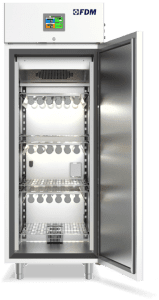
How many climate parameters can be altered in the laboratory?
On these pages we often talk about temperature, relative humidity but also solar lighting and rainfall simulation.
Less often we deal with the oxygen density which is the main parameter taken into account by the Hypoxia Chamber.
In today's article we will see what it consists of and what its main uses are.
What is Hypoxia and How is it Achieved
Hypoxia is a word of Greek origin that describes the lack of oxygen in an organism.
In medicine, it is used to describe a pathological condition; but certain levels of hypoxia (non-lethal) are reproduced daily on living organisms both in the context of scientific research and in the training of professional athletes.
In nature, hypoxia occurs mostly in high altitude contexts, such as mountains where, as is known, there is a lower density of oxygen.
Per questo motivo, lo strumento da laboratorio in grado di alterare i livelli di ossigeno e causare ipossia, è noto sia come Camera di Ipossia che come Camera di Altitudine.
How the Hypoxia Chamber Works
The hypoxia chamber is a technologically advanced laboratory instrument that allows for the accurate regulation of oxygen levels and other environmental parameters.
Like climatic chambers, the hypoxia chamber consists of an environment hermetically isolated from the outside, of variable size, in which a microclimate is simulated which allows the carrying out of tests and experiments.
Illumination Chamber
Discover the latest features of FDM Growth Chambers.
Hypoxia Chamber for Athletes
Among the uses of the hypoxia chamber, training for professional athletes is among the best known and most fascinating.
These hypoxia chambers are much larger than those used for scientific research because they must allow the athlete to enter and guarantee him freedom of movement. Technically, they fall into the class of climatic chambers called walk-in, of which we talked here.
Athletes benefit from training in simulated hypoxic conditions, as this can improve oxygen use efficiency and stimulate red blood cell production. The hypoxia chamber therefore becomes a key asset for professional athletes and enthusiasts seeking to maximize their performance and gain a competitive advantage in a safe and controlled manner.
Hypoxia Chamber for Bacterial Cultures
In the field of scientific research, however, the main use of hypoxia chambers concerns the growth of bacterial and cell cultures.
Low oxygen levels, in fact, significantly influence the growth of some species and their proliferation. Unlike those for athletes, these rooms are generally very small. Some hypoxia chambers for bacterial cultures are also relatively simple, with oxygen levels being the only parameter they can alter.
Not all bacterial cultures, however, can be managed in a hypoxia chamber.
You cannot find the ideal chamber for your test?
Create your own environment, according to any test requirement
The FDM Growth Chamber
Oxygen is not the only parameter to keep under control regarding the culture of cells, bacteria and microorganisms.
Temperature, relative humidity and lighting are key factors that allow almost complete control over the organisms in question.
This is why FDM growth chambers are the most suitable tool for research on cells, bacteria and microorganisms. Thanks to the best technology on the market, our growth chambers can regulate temperature and relative humidity with extreme precision. Furthermore, 5 different sets of lamps are available to suit the needs of each researcher.
For further doubts and questions, please do not hesitate to contact us.
Would you like to receive a quote or do you have questions about the product?
Contact us to receive more information about this Product.



